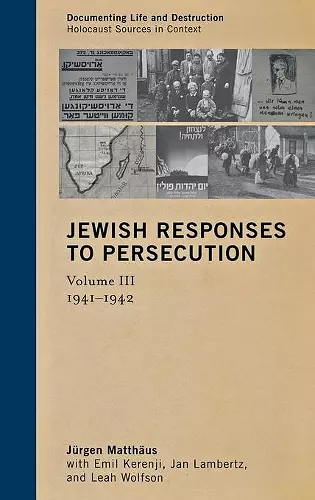Jewish Responses to Persecution
1941–1942
Jürgen Matthäus author Emil Kerenji author Jan Lambertz author Leah Wolfson author
Format:Hardback
Publisher:AltaMira Press
Published:18th Apr '13
Currently unavailable, and unfortunately no date known when it will be back

Jewish Responses to Persecution: 1941–1942 is the third volume in a five-volume set published in association with the United States Holocaust Memorial Museum that offers a new perspective on Holocaust history. Incorporating historical documents and accessible narrative, this volume sheds light on the personal and public lives of Jews during a period when Hitler’s triumph in Europe seemed assured, and the mass murder of millions had begun in earnest. The primary source material presented here, including letters, diary entries, photographs, transcripts of speeches, newspaper articles, and official memos and reports, makes this volume an essential research tool and curriculum companion.
This book’s numerous documents, some previously published but many translated from archival sources for the first time, include heart-stabbing expressions of pain,fear, despair, doomed hope, and innocent delusion. They flow mainly from Jewish sufferers’ pens, with none from the perpetrators’ bureaucracy. The voices are mostly Central or East European, but there are also gripping testimonies from southeastern Europe, the Netherlands, and France. . . .Otherwise, the political documents expose, though without recrimination, the self-delusion and sometimes self-serving attitudes of Jewish leaders in Allied lands, and of members of Judenräte and the Jewish Police in the ghettos. This collection puts myriad significant documents into teachers’ and students’ hands. . . .[T]hese documents illuminate individual fates in a wide range of geographical and socio-cultural settings. Reading such sources, we need not reject the challenge of fashioning a wide-ranging interpretation of Hitlerism and the Holocaust—a historical and philosophical tool much needed if the barbed wire is to be cut. At the start, however, we must recognize that individual fates possess their own existential and epistemological autonomy. * Holocaust and Genocide Studies *
This impressive series provides a sense of the depth and diversity of contemporary Jewish documents while embedding them in explanatory narratives. . . .The third volume covers the months between the beginning of 1941 and the summer of 1942, when Nazi Germany’s belligerent expansion produced mass death on a colossal scale and Hitler’s demise remained anything but certain. . . . As is shown in Volume III, Jewish reactions around the time of the emergence of the ‘Final Solution’ were often highly specific to the situation in which Jews found themselves, but were also affected by long-term traditions, beliefs, norms, past experiences, communal bonds, and personal loyalties. As the editors convincingly argue, forming a coherent image of the Nazi genocide might have been exceedingly difficult for the persecuted, but they certainly did not remain silent about the unprecedented developments they were forced to experience. However, as the editors elaborate in their nuanced and sobering assessment, what was missing during 1941–1942 was not breaking the silence, but amplifying the dreadful firsthand accounts of mass murder in a way that they would ‘reach a wider audience, become integrated into a coherent narrative, and trigger political intervention.' * Yad Vashem Studies *
This superbly compiled volume takes us as close as it is possible to get to the experience of Jews living under Nazi German and Axis rule when persecution morphed into mass murder and, then, genocide. Using myriad contemporary sources composed by Jews—ranging from those in authority to children in hiding, from Norway to southern Italy, from the peaceful streets of Paris to the mayhem of the Warsaw ghetto—it forces us to confront the kaleidoscope of suffering and barriers to comprehension. In diaries, letters, reports, and the press we meet political activists, secular intellectuals, rabbis, poets, ‘mixed race’ Jews, converts to Christianity, and relief workers in neutral countries struggling to comprehend events. This brilliant anthology thwarts the customary generalizations about Jewish responses. It reveals a spectrum of ways in which individuals, increasingly isolated and fearful, doggedly adjusted to catastrophic circumstances that only a few realized were ultimately a prelude to even worse. This volume, along with others in the series, will change the way that the persecution and mass murder of the Jews is taught and, eventually, will transform popular understanding of the past. -- David Cesarani, Royal Holloway College, University of London; author of Becoming Eichmann
This third volume in the Jewish Responses to Persecution series is a tremendous work of documentation and scholarship. It offers a starkly different perspective on the beginning of Nazi mass-killing operations in 1941 and 1942. Unlike other documentary collections and works of scholarship, which focus on the Nazi decision-making process and the expansion of killing operations, this work reveals what mass murder meant and how it was perceived by the Jewish men, women, and children facing death and by Jews in a variety of situations around the globe. Readers of this volume will substantially deepen and even rethink their prior understandings of a range of topics relating to the unfolding genocide of European Jews. -- Alexandra Garbarini, Williams College
This volume, highlighting the years 1941 to 1942 when the trajectory of genocide escalated from pogroms to mass shootings and then to gas chambers, covers not only Europe but also areas around the globe threatened by the Nazis. Embedded in an excellent narrative, the carefully selected documents help us see the Holocaust through the eyes of its victims as they depict a broad range of responses from elite to ordinary Jews, from organizations to individuals. As Jews try to understand what was happening around them, their voices cry out in confusion, in disbelief, in agony. -- Marion Kaplan, New York University
ISBN: 9780759122581
Dimensions: 235mm x 161mm x 38mm
Weight: 1002g
584 pages